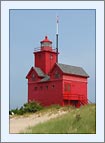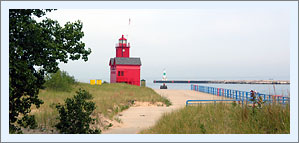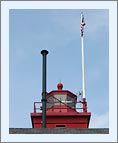 |
 |
 |
| Click thumbnails to view enlarged images | ||
| Holland Harbor Light | Seeing The Light |
|
|
|
|
Historical Information When scouting-out a location in which to establish a settlement for his Dutch emigrant followers in 1847, the Reverend A. C. Van Raalte immediately foresaw the potential of the Black Lake area, and established the Holland settlement on the lake’s south eastern shore. As was the case with almost all of the rivers and lakes which fed into Lake Michigan’s eastern shore, the small outlet at Black Lake was blocked by a sand bar formed by wave action depositing sand across the river opening, thereby limiting access to the river to vessels of only the shallowest draft. Realizing that direct access to Black Lake from Lake Michigan for larger vessels would significantly enhance the growth of the community, Van Raalte began lobbying political representatives in an attempt to obtain Federal funding for the necessary harbor improvements. On Van Raalte’s behalf, Michigan Representative Charles E. Stuart presented a memorial before The House on February 1, 1849 signed by Holland’s 600 residents praying for "the erection of a light-house and the improvement of the harbor at the mouth of the Black River." However, Congress turned a deaf ear to the request and to all subsequent resolutions and memorials presented on Van Raalte’s behalf. Frustrated with continuing Federal inaction, the Dutch settlers began the work of dredging the new channel themselves. On completion of the work on July 1, 1859, the small steamboat HURON became the first vessel to make its way through the channel into Black Lake and down the lake to Holland itself. Congress finally responded to Van Raalte’s ongoing pleas for assistance in 1867, and the Army Corps of Engineers was dispatched to Holland to begin improvements two years later. With a pair of protective piers at the Lake Michigan end of the channel under construction in 1870, the Lighthouse Board recommended the establishment of a light at their outer end to guide mariners into the channel. Congress responded with an appropriation of $6,000 for the establishment of the Light on July 1, 1870, and with completion of the piers planned for late that season, Eleventh District Lighthouse Engineer Brevet Brigadier General Orlando M. Poe approved the plans and specifications for establishing a pierhead beacon soon thereafter.
Holland resident Melgert Van Regenmorter was appointed as the station’s first keeper on December 3rd, 1870, and exhibited the light for the first time soon thereafter. While the construction estimates included sufficient funds for the erection of a keeper’s dwelling on shore, the owner of the property selected for the dwelling was unable to prove clear title to the site, and the remaining funding reverted back to the Treasury. Thus, Van Regenmorter was forced to find accommodation elsewhere until more permanent arrangements could be made. While Congress made a new appropriation for construction of the dwelling on June 10, 1872, continued problems encountered in obtaining clear title to the selected property were encountered, and Van Regenmorter continued to make his own housing arrangements. 1874 saw the erection of 550 feet of elevated timber framed walkway lading from a point 450 feet from the shoreline out to the door of the beacon service room. connecting the door in the beacon service room. Designed to allow the keeper to make his way along the pier above the waves which frequently crashed across the top of the pier, 450 feet of plank walk were also installed from the inner end of the elevated walk to shore across the top of the open stone-filled pier cribs to provide secure footing. While our research has yet to identify the year in which the dwelling was built, there is a record of the arrival of a work crew to conduct repairs to the dwelling in 1880. Thus, the dwelling was evidently built at some time between 1873 and 1880. Also in 1880, the elevated walkway on the pier was extended an additional 264 feet toward the shore, bringing its total length to 814 feet. Timber exposed to constant wetting and drying cycles is extremely susceptible to rot, and this was inevitably the case with the elevated walk at Holland Harbor, as 600 feet of its length was replaced in 1885. While the construction of the piers served well to open Black Lake to larger vessels, the relatively narrow 200-foot opening between the piers represented a considerable challenge to vessel masters attempting to gain entry during heavy seas, and a number of accidents were experienced as a result. On a stormy October 23, 1887, a vessel of unrecorded name smashed into the beacon service room while entering the harbor, causing considerable damage to the structure. A repair crew was quickly dispatched to Holland to effect repairs. While on site, the crew also made some repairs to the dwelling and installed a tin hood above the lens to contain heat. To serve as a front range to the existing beacon, a tubular lantern was erected on a 20-foot tall post on the outer end of the south pier in 1890. This post was destroyed by a scow aptly named BREAKAWAY on entering the harbor on September 13, 1891, and a temporary light was shown until a work crew could be dispatched to effect repairs. The following year, the schooner R KANTERS ran her bowsprit into the elevated walk while leaving the harbor, requiring the replacement of three legs and the associated stringers and railing. By the dawn of the twentieth century, a number of resort hotels had sprung up around Black Lake, which had been renamed Lake Macatawa, and Holland became a major vacation destination for Chicago and Milwaukee vacationers. In 1900 alone, over 1,100 vessels made their way between the piers bringing vacationers and weekend trippers to enjoy Holland’s quiet charm. With the resulting increase in maritime commerce, the Lighthouse Board recommended the establishment of a fog signal station at the harbor entrance, and estimating costs of an appropriate installation to be $6,000, requested an appropriation in this amount in its annual report for the 1900 fiscal year. The following year, a cable and pulley system was erected between the beacon and the post light. The system was designed to allow Keeper Van Regenmorter to tend the lantern from the shelter of the beacon service room by pulling the lantern to and from the post.
Showing signs of continued deterioration, 1903 saw the replacement of 217 feet of timber elevated walk with cast iron supports and handrails. 216 additional feet of timber walkway was also replaced with similar cast iron walkway sections the following year. In a major gale on December 22, 1904, the outer crib on which the steel pierhead light stood was pushed off center by the force of the sea, and had taken on a noticeable lean. Fearing that the structure might topple into the lake, the tower was disassembled and shipped to the St. Joseph Lighthouse Depot for repair. A wooden foundation pier was erected, and the repaired tower returned to Holland, where it was again hoisted on the rebuilt pier and bolted in place. After six years of repeated requests for the $6,000 appropriation for the establishment of a fog signal at the Harbor entrance, Congress had failed to respond to responded. Still deeming the establishment of the signal of critical importance, Ninth District Engineer Major James G. Warren searched for another possible solution. Identifying that a $7,l500 of July 1, 1898 for establishing a fog signal station on the Breakwater in Milwaukee Harbor remained as yet unexpended, Warren recommended that legislative authority be granted to divert the unexpended funds to allow for the establishment of the fog signal at Holland.
Congress responded favorably to Major Warren’s request on June 30, 1906, stating "the Light-House Board is authorized to expend not to exceed $6,000 out of the appropriation made by the act approved July first, eighteen hundred and ninety-eight, for building South Milwaukee, Wisconsin, light-station in the establishment of Holland pierhead range light-station, Michigan." Rather than expend the cost of designing a unique set of plans for the new structure, the decision was made to use a plan that was also planned for use at Waukegan, and would also end up being used at Kewaunee a few of years later.
A pair of arrowhead breakwaters were erected from the end of the piers in 1916, and a red oval tower standing 27 feet in height was erected at the end of the south breakwater in order to form a range with the South Pierhead beacon. The red flashing acetylene powered lantern at a focal plane of 30 feet atop this tower was visible for a distance of 7 miles. With the addition of this new light, the characteristic of the light in the pierhead beacon was also changed on May 30, 1916 to exhibit a red flash every 4 seconds.
A Coast Guard crew arrived in Holland in 1956, and gave the combined fog signal building and lighthouse a fresh coat of bright red paint in order to conform to its "Red Right Return" standard, which called for all aids to navigation located on the right side of a harbor entrance to be red in coloration. Local residents thus began referring to the fifty year old structure as "Big Red," a name which has stuck through the years. The Fourth Order lens was subsequently removed from the fog signal lantern in the late 1960’s, and replaced with a 250 mm Tidelands Signal acrylic optic.
Reference Sources Personal observation at Holland, 09/25/1999 Lights Of The Lakes, Chris Duncan, Mich. Coastal Mgmt. Program, 06/07/1984 Michigan historical markers at Harbor & Lighthouse, erected 1987 Holland City News, 08/01/1874 USCG Historians office, Photographic archives. Keeper listings for this light appear courtesy of Great Lakes Lighthouse Research |